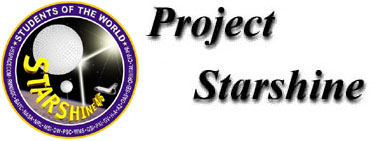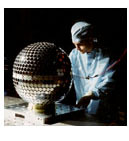

Michael A. Savell.
 
|
John Vasquez of the Naval Research
Laboratory prepares Starshine 1 for
vibration test. Photo by Michael A. Savell. |
|
STARSHINE 4/5 UPDATE - April 21, 2002
|

|
We have inspected all the polished Starshine 4 mirrors received to date and have found 825 of them to be acceptable for flight. Here is a picture of the stack of boxes that came in prior to the March 31 deadline. Additional mirrors continue to trickle in from all over the world, so it looks as though we may finally receive enough of them to cover the satellite. If not, we'll use diamond-turned mirrors from Hill Air Force Base in Utah to finish the job. If you are in an overseas school that received its kit late, because of shipping delays that were encountered between the U.S. and your country, please send an email to gilmoore12@aol.com to let us know when you received your kit and when you expect to get your polished mirrors into the mail. Please do not forget to send along your signed name sheets to |
|
Starshine
Headquarters, 3855 Sierra Vista Road, Monument, Colorado 80132-8216 USA,
so we can scan them onto a CD-ROM for placement inside the Starshine 4
satellite.
To view a list of the schools and other groups that requested and received Starshine 4 mirror polishing kits, click here. You can see which of them have returned their mirrors to us, as of April 20, 2002. We have now mailed to the Space Optics Manufacturing Technology Center of NASA's Marshall Space Flight Center in Huntsville, Alabama, all the mirrors we have received to date. |
|
We're going to release a 4 inch (10 cm) hollow aluminum sphere from the interior
of Starshine 4, shortly after Starshine 4 is deployed from Space Shuttle Atlantis
in January 2003. We're calling this subsatellite Starshine 5.
Both Starshines 4 and 5 will carry 31 laser retroreflectors on their surfaces and will be tracked by the International Satellite Laser Ranging Network (ISLR) and the U.S. Space Command. In addition, Starshine students will visually track the faint flashes of sunlight reflecting from 1000 polished mirrors mounted on the surface of Starshine 4. All these data will be combined to determine the orbit of Starshine 4. Starshine 5 will have no mirrors and will thus not be naked-eye visible, so we will depend totally on ISLR and Space Command tracking for orbit determination of this satellite. By comparing the orbital decay rates of Starshines 4 and 5, it will possible for us to determine the density of the earth's atmosphere more precisely than we've been able to do on previous missions.
 Click Here for 300 DPI version |
Return to Project Starshine Home Page
Last Updated: April 21, 2002